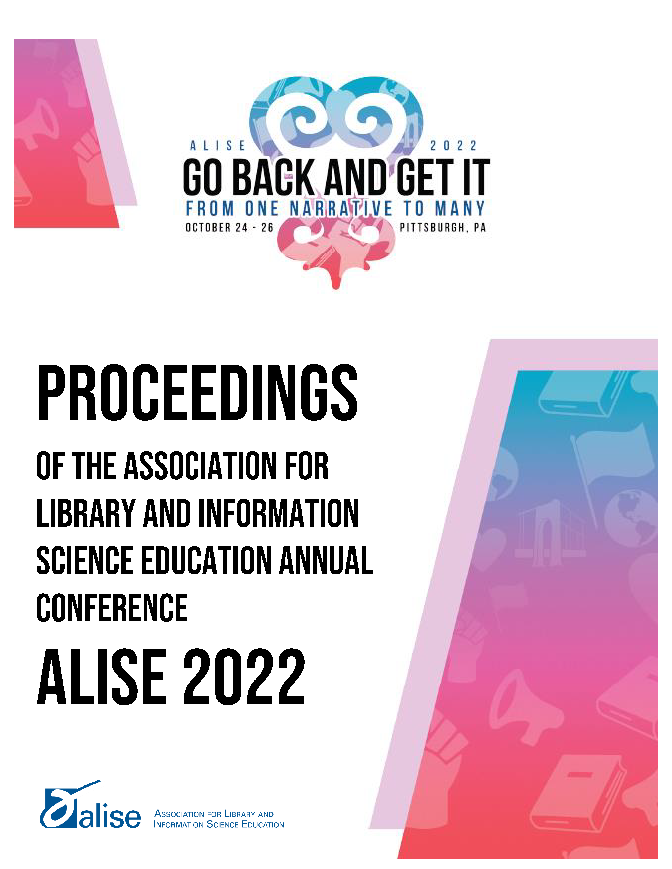Many Narratives
Storytelling as Epistemological Bridge
DOI:
https://doi.org/10.21900/j.alise.2022.1072Keywords:
storytelling, youth services, LIS history, innovation, DIKWAbstract
Storytelling bridges a key epistemological divide in our field between socially constructed humanism of children’s story time and implicit positivist orientation of computational systems. Centering story and storytelling as fundamental to LIS calls for a richer variety of stories, tellers, and audiences for a future of greater inclusion.
References
Agosto, D. E. (2013). If I Had Three Wishes: The Educational and Social/Emotional Benefits of Oral Storytelling. Storytelling, Self, Society, 9(1), 53–76. https://doi.org/10.13110/storselfsoci.9.1.0053
Agosto, D. E. (2016). Why Storytelling Matters: Unveiling the Literacy Benefits of Storytelling. Children and LIbraries, 14(2), 21–26. https://doi.org/10.5860/cal.14n2.21
Armstrong, P. B. (2020). Stories and the brain: The neuroscience of narrative. Johns Hopkins University Press.
Baker, A., & Greene, E. (1977). Storytelling: Art and technique. Bowker.
Berger, P. L., & Luckmann, T. (1966). The social construction of reality: A treatise in the sociology of knowledge. Doubleday.
Bishop, K., & Kimball, M. A. (2006). Engaging Students in Storytelling. Teacher Librarian, 33(4), 28–31.
Chatman, E. A. (1996). The impoverished life-world of outsiders. Journal of the American Society for Information Science, 47(3), 193–206. https://doi.org/10.1002/(SICI)1097-4571(199603)47:3<193::AID-ASI3>3.0.CO;2-T
Colón-Aguirre, M. (2015). Organizational Storytelling Among Academic Reference Librarians. Portal: Libraries and the Academy, 15(2), 233–250.
Cooke, N. A. (2017). Information services to diverse populations: Developing culturally competent library professionals. Libraries Unlimited, an imprint of ABC-CLIO, LLC,.
Del Negro, J. (2017). Engaging teens with story: How to inspire and educate youth with storytelling. Libraries Unlimited, An Imprint of ABC-CLIO.
Dousman, M. E. (1896). Children’s Departments. Library Journal, 21(9), 406–408.
Hearne, B. (1993a). Cite the Source: Reducing Cultural Chaos in Picture Books, Part One. School Library Journal, 39(7), 22–27.
Hearne, B. (2011). Folklore in Children’s Literature: Contents and Discontents. In S. Wolf, K. Coats, P. Enciso, & C. Jenkins (Eds.), Handbook of Research on Children’s and Young Adult Literature2 (pp. 209–223). Routledge.
Hearne, B. (1993b). Respect the Source: Reducing Cultural Chaos in Picture Books, Part Two. School Library Journal, 39(8), 33–37.
Hedemark, Å., & Lindberg, J. (2018). Babies, bodies, and books—Librarians’ work for early literacy. Library Trends, 66(4), 422–441. https://doi.org/10.1353/lib.2018.0011
Hjørland, B. (2005). Empiricism, rationalism and positivism in library and information science. Journal of Documentation, 61(1), 130–155. https://doi.org/10.1108/00220410510578050
Holland, G. A. (2006). Associating social constructionism and extended cognition in information studies. Journal of Documentation, 62(1), 91–100. https://doi.org/10.1108/00220410610642066
Holt, D., & Mooney, W. (1994). How do I make a program flow? In Ready-to-tell tales: Surefire stories from America’s favorite storytellers (pp. 68–76). August House.
Leeds-Hurwitz, W. (2012). Social Construction of Reality. In S. Littlejohn & K. Foss (Eds.), Encyclopedia of Communication Theory (pp. 891–894). SAGE Publications, Inc. https://doi.org/10.4135/9781412959384.n344
Lipman, D. (1999). Improving your storytelling: Beyond the basics for all who tell stories in work or play. August House.
Ma, Y. (2021). Understanding information: Adding a non‐individualistic lens. Journal of the Association for Information Science & Technology, 72(10), 1295–1305.
MacDonald, M. R. (1993). The storyteller’s start-up book: Finding, learning, performing, and using folktales including twelve tellable tales. August House.
McDowell, K. (2020). Storytelling, Young Adults, and Three Paradoxes. In A. Bernier (Ed.), Transforming Young Adult Services, second edition (2nd ed., pp. 93–109). American Library Association-Neal Schuman.
McDowell, K. (2021). Storytelling wisdom: Story, information, and DIKW. Journal of the Association for Information Science and Technology, 72(10 (Special Issue: Paradigm Shift in the Field of Information)), 1223–1233. https://doi.org/10.1002/asi.24466
McDowell, K., Cooke, N. Social Justice Storytelling: A Pedagogical Imperative. Library Quarterly (in press.)
Overall, P. M. (2009). Cultural Competence: A Conceptual Framework for Library and Information Science Professionals. Library Quarterly, 79(2), 175–204. Library & Information Science Source. https://www.journals.uchicago.edu/doi/10.1086/597080
Patin, B., Sebastian, M., Yeon, J., Bertolini, D., & Grimm, A. (2021). Interrupting epistemicide: A practical framework for naming, identifying, and ending epistemic injustice in the information professions. Journal of the Association for Information Science and Technology, 72(10), 1306–1318. https://doi.org/10.1002/asi.24479
Pellowski, Anne. (1977). The world of storytelling. Bowker.
Polletta, Francesca. (2006). It Was Like a Fever: Storytelling in Protest and Politics. University of Chicago Press. https://doi.org/10.1177/009430610803700327
Poole, A. H., Agosto, D., Greenberg, J., Xia Lin, & Erjia Yan. (2021). Where Do We Stand? Diversity, Equity, Inclusion, and Social Justice in North American Library and Information Science Education. Journal of Education for Library & Information Science, 62(3), 258–286. https://doi.org/10.3138/jelis.2020-0018
Rayward, W. B. (1994). Visions of Xanadu: Paul Otlet (1868-1944) and Hypertext. Journal of the American Society for Information Science, 45(4), 235–250. https://doi.org/10.1002/(SICI)1097-4571(199405)45:4<235::AID-ASI2>3.0.CO;2-Y
Rizzolatti, Giacomo. (2008). Mirrors in the brain: How our minds share actions and emotions (C. Sinigaglia, Ed.). Oxford University Press.
Roshanaei, M., Tran, C., Morelli, S., Caragea, C., & Zheleva, E. (2019). Paths to empathy: Heterogeneous effects of reading personal stories online. Proceedings - 2019 IEEE International Conference on Data Science and Advanced Analytics, DSAA 2019, 1, 570–579. https://doi.org/10.1109/DSAA.2019.00072
Roy, L. (2015). Advancing an Indigenous Ecology within LIS Education. LIBRARY TRENDS, 64(2), 384–414.
Sawyer, R. (1942). The way of the storyteller. The Viking Press.
Sims Bishop, R. (2003). Reframing the Debate about Cultural Authenticity. In D. Fox & K. G. Short (Eds.), Stories Matter: The Complexity of Cultural Authenticity in Children’s Literature. National Council of Teachers of English.
Sturm, B. W. (1999). The Enchanted Imagination: Storytelling’s Power to Entrance Listeners. School Library Media Research, 2, 1–21. https://eric.ed.gov/?id=EJ593526
Sturm, B. W., & Nelson, S. B. (2016). With Our Own Words: Librarians’ Perceptions of the Values of Storytelling in Libraries. Storytelling, Self, Society, 12(1), 4–4. https://doi.org/10.13110/storselfsoci.12.1.0004
Downloads
Published
Issue
Section
License
Copyright (c) 2022 Kate McDowell

This work is licensed under a Creative Commons Attribution-ShareAlike 4.0 International License.



